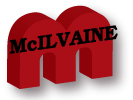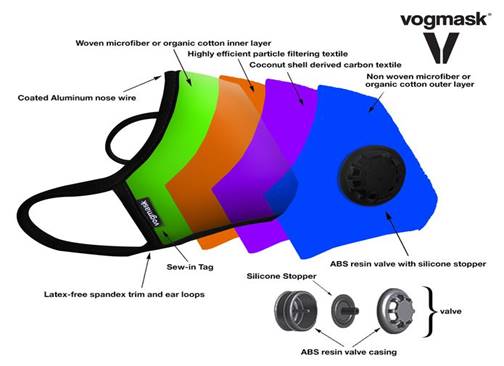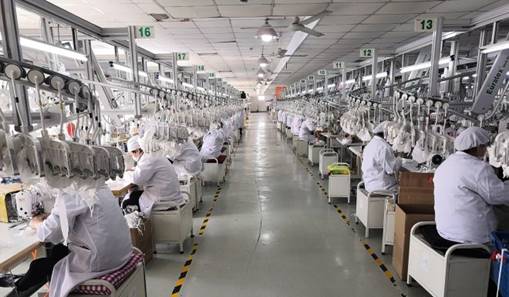
Coronavirus Technology Solutions
April 6, 2020
The U.S. Forcing 3M to Ship
Masks from Offshore Plants to
the U.S.
The Mask Market Could Soar from
a few billion per year to
hundreds of billions
Studies Document the Air
Transmission of the Virus
Halyard Proposal for Mask Making
Equipment Anticipating a
Pandemic Rejected in 2018
More than 40 Designs of Facemask
Available from Halyard
H&M Making N95 Masks through
Chinese Plant
Honeywell to Produce 20 million
N95 Masks per month in the
Phoenix and RI Plants
3M Targeting 2 billion N95 Masks
per Year by Early 2021.
Keeping Score on Medical and N95
Mask Production
Shortage of Meltblown Fabric for
Face Masks
Sinopec can Make 5 million N95
Masks per day
_______________________________________________________
The U.S. Forcing 3M to Ship
Masks from Offshore Plants to
the U.S.
The Trump administration is
trying to use its wartime powers
to cut off 3M’s ability to
export face masks abroad, as
well as claim more of the masks
the company manufactures in
other countries for use in the
United States. Such a policy
would be a dramatic expansion of
the U.S. government’s reach as
it seeks to procure much-needed
protective gear for American
health care workers.
But some trade and legal experts
fear new mandates could
backfire, causing other
governments to clamp down on
exports of masks, ventilator
parts and pharmaceuticals that
the United States desperately
needs. They have also questioned
whether the Defense Production
Act gives the government the
authority to commandeer goods
made beyond United States
borders.
In a statement on Friday, 3M
said that the administration had
requested that 3M increase the
amount of respirators the
company imports from its
overseas operations into the
United States, and that 3M was
complying. Earlier this week, it
secured approval from China to
export to the United States 10
million N95 respirators the
company makes in China, it said.
The company added that the
administration had also asked 3M
to stop exporting respirators
that are manufactured in the
United States to Canada and
Latin America — a request it
said carried “significant
humanitarian implications” for
people in those countries. (this
is the evaluation covered in the
McIlvaine presentation during
the April 2 webinar which
provides a metric to make these
decisions without the need for
making humanitarian decisions
arbitrarily)
The Mask Market Could Soar From
a Few Billion Per Year to
Hundreds of Billions
At a choir practice in a
Washington State Church in
February precautions including
sanitizing everything and social
distancing were taken during the
two hours when 60 people
assembled.
Yet 45 of them contracted
the coronavirus. The conclusion
was that the act of singing
created an air transmission
route which was deadly. Hundreds
of Diamond Princess passengers
were not infected until they
spent weeks in their cabins
breathing the air from a common
HVAC system.
When the air transmission of
droplets smaller than 5 microns
is accompanied by interaction of
individuals who may not show
symptoms you create a situation
where masks become very
important. It is not surprising
that the Chinese death toll per
capita is very small compared to
Italy. For Chinese efficient
masks have been purchased for
years.
Vogmask opened its first retail
store in China in 2013.
This U.S. based company
had all the needed testing on
efficiency and resistance done
by Nelson laboratories.

These stores have the aura of a
sportswear store elsewhere in
the world. The masks sell for
$33 but can be washed 20 or more
times.

If
just ten percent of the world’s
population wore these masks that
would be 800 million wearers
With 20 wearings the cost
per wearing would be $1.50.
This alone would create a
$1.2 billion per day market or
$438 billion per year.
But
the poorer people could also be
wearing effective masks. China
is making N95 quality masks with
a nanofiber laminate on a cotton
backing.
The masks can be washed
at least 20 times at a cost per
day of just 15 cents.

If
2 billion people were wearing
these masks the cost would be
$300 million per day. Or $109
billion per year.
This would create a
market of over $500 billion per
year for mask makers. Based on
the cost of a life lost at $50
million this expense can be
justified if just 10,000 lives
are saved per year.
The
question for media and mask
makers is how long will this
boom last? The answer is very
likely 36 months and very
possibly permanently. It is
expected that the southern
hemisphere will experience an
epidemic during the northern
summer. Then infected
individuals will travel North
and there will be a spike in the
winter of 2020-21.
The
practice of wearing masks is
likely to be permanent for the
following reasons
·
Fear of another pandemic with a
new virus
·
Realization that there are
millions of cases of flu each
year and some can be prevented
·
The
emotional phenomena
which could cause an
exaggerated view of the risk
similar to fear of being eaten
by a shark if swimming in the
ocean.
·
Demonstration of compassion –
not wanting to infect anyone
with anything
The
nanofiber laminates create all
sorts of possibilities. There
are also new designs available
which provide a permanent mask
with replaceable media.
At least one Chinese
company is offering this design.
Exxon Mobil just announced a
design which provides improved
coverage of
the nose and mouth in a
structure which can withstand
repeated sterilization. A
replaceable cartridge with N95
efficiency is utilized.
Exxon Mobil is waiting for FDA
approval and then hopes to
produce 40,000 masks and
cartridges per hour.
Studies Document the Air
Transmission of the Virus
Air
contaminated with the COVID-19
virus might travel four times
farther than the 6 feet the
CDC asks we distance ourselves,
according to a recent study.
The study
published in the Journal
of the American Medical
Association found that
under the right conditions,
liquid droplets from sneezes,
coughs and just exhaling can
travel more than 26 feet and
linger in the air for minutes.
Findings such
as these may have some bearing
on the CDC's
recommendation on Friday that
Americans wear non-surgical face
masks in public —
especially in places "where
other social distancing measures
are difficult to maintain."

Halyard Proposal for Mask Making
Equipment
Anticipating A Pandemic
Rejected in 2018
In
September 2018, the Trump
administration received detailed
plans for a new machine designed
to churn out millions of
protective respirator masks at
high speed during a pandemic.
The
plans, submitted to the
Department of Health and Human
Services (HHS) by medical
manufacturer O&M Halyard, were
the culmination of a venture
unveiled almost three years
earlier by the Obama
administration. But HHS did not
proceed with making the machine.
The
project was one of two N95 mask
ventures — totaling $9.8 million
— that the federal government
embarked on over the past five
years to better prepare for
pandemics.
The
other involved the development
of reusable masks to replace the
single-use variety.
The Halyard contract was part of
an explicit strategy to ensure
we could surge mask production
in the next crisis,” said Nicole
Lurie, who was the HHS assistant
secretary for preparedness and
response under Barack Obama.
The projects did not
proceed. The company is
expanding N95 production and may
consider this approach as part
of the program.
More than 40 Designs of Facemask
Available from Halyard
The various designs from Halyard
contain features which might be
more widely adapted in the
pandemic era.
One with an expanded
chamber would assumedly offer
more surface area and therefore
less resistance. So that a more
efficient media could be used
with no more pressure drop than
the standard mask.
HALYARD* Blue Level 1 Surgical
mask meets all five ASTM
requirements for level 1
protection and comes with an
expanded chamber to provide the
user with additional space.

Halyard also has a high
filtration face mask with 97%
BFE and PFE ratings

H&M Making N95 Masks Through
Chinese Plant
Sweden’s H&M, the world’s
second-biggest fashion retailer,
said on Friday it had started
production of protective face
masks for hospital staff and
would ship the first batches to
Spain and Italy.
“At
this first stage, 100,000 face
masks will be produced and ready
for delivery on April 2. Half
will go to Italy and half to
Spain. It is a factory in China
that makes the masks,” a H&M
spokeswoman said in an email.
H&M
in early April said it was
looking into using its supply
network to source personal
protective equipment for
hospitals to help curb the
spread of the coronavirus.
The
masks are of the N95/FFP2
standard that protects from the
droplets through which the virus
spreads.
Honeywell to Produce 20 million
N95 Masks per Month in the
Phoenix and RI Plants
Honeywell announced that it is
adding manufacturing
capabilities in Phoenix to
produce N95 face masks in
support of the U.S. government’s
response to the novel
coronavirus (COVID-19).
The company’s Phoenix expansion,
coupled with previously
announced new production in
Rhode Island, will allow
Honeywell to produce more than
20 million N95 disposable masks
monthly to combat COVID-19 in
the U.S. New manufacturing
equipment to support the effort
will arrive in Phoenix beginning
this week.
“We at Honeywell are proud of
our role in providing essential
equipment to the first
responders and medical
professionals we are relying on
during this crisis,” said Darius
Adamczyk, Honeywell chairman and
chief executive officer. “We
have moved quickly to expand our
production capacity for N95
masks globally and are pleased
to announce our second new U.S.
manufacturing line to supply the
Strategic National Stockpile.”
Honeywell anticipates that the
new mask production line in
Phoenix will create more than
500 new jobs in Arizona. The
company has already begun
recruiting, hiring and training
manufacturing workers on the
site. Today’s announcement
brings the total number of U.S.
jobs created by Honeywell’s new
mask manufacturing capabilities
to more than 1,000.
The N95 face masks will be
delivered to the U.S. Department
of Health and Human Services to
contribute to the American
stockpile for use to support
health, safety and emergency
response workers. The Phoenix
facility will prioritize
fulfilling the U.S. government’s
procurement, but it will also
have the capacity to produce
face masks for U.S. states and
American healthcare and
emergency response
organizations.
Honeywell’s production expansion
will also support additional
American businesses, including
industrial equipment providers
and raw materials suppliers. The
company is collaborating with
state and local officials to
ramp up production efforts and
support hiring and training.
Honeywell’s Phoenix Engines
campus is one of the company’s
largest, and since 1950 has been
dedicated to the design and
manufacture of propulsion
engines and auxiliary power
units for a variety of
commercial and military
aircraft. The facility will
continue its aircraft technology
manufacturing operations
alongside the new protective
gear production.
3M
Targeting 2 billion N95
Masks per year by Early 2021.
In
early 2020 health officials
worried there were not nearly
enough of them. In early March,
officials from the U.S.
Department of Health and Human
Services said the country had
only about 35 million of the 3.5
billion N95 respirators needed
in the event of a full-blown
pandemic.
3M
doubled global production to 1.1
billion per year from about 400
million per year, and the
company said in late March it
plans to double production again
to 2 billion within 12 months.
The
explosion of face mask demand
could provide a small boost for
3M, which reported sales of
about $32 billion in 2019. The
company does not break down the
actual size of its face mask
business, but some Wall Street
analysts estimate 3M sold
anywhere from $100 million to
$325 million in face masks prior
to the outbreak of the disease.
The outbreak could add another
$300 million in sales, said one
analyst.
This
would be only a tiny portion of
3M’s overall business, but the
importance of the product still
has focused a tremendous amount
of attention on the company.
Keeping Score on Medical and N95
Mask Production
Information on mask production
around the world is voluminous,
confusing and inconsistent.
Here are some of the
latest figures.
Keeping Score on N95 Masks –
Millions Produced
|
Day |
Month |
Year |
|
|
Sinopec melt blown |
8 (May) |
240 |
2,880 |
|
3M in future |
5.6 |
167 |
2,000 |
|
U.S Need |
9.7 |
291 |
3,500 |
|
Amer. Mfgrs. now |
1.66 |
50 |
600 |
|
Honeywell in future |
0.66 |
20 |
240 |
The
Sinopec facilities can make
either medical masks or N95
masks. So it is not certain what
percentage is devoted to N95
production at any one time.
Keeping Score on Medical Masks –
Millions Produced
|
Entity |
Day |
Month |
Year |
|
China - March 2020 |
200 |
6000 |
72,000 |
Shortage of Meltblown Fabric for
Face Masks
Currently, of the 200 million
masks China makes a day, only
600,000 are N95 standard masks,
used by medical personnel,
according to the National
Development and Reform
Commission, a state planning
body.
This is
out of date as per the new
Sinopec capacity as shown above.
Provincial regulators have
granted dozens of new licenses
to open additional factories
capable of producing top-grade
masks, including those that meet
the standards for use by
health-care professionals.
But this ambitious effort has
run into a bottleneck. Both the
masks made for medical personnel
and for consumer purchase
require a once-obscure material
called melt-blown fabric. It's
an extremely fine mesh of
synthetic polymer fibers that
forms the critical inner
filtration layer of a mask,
allowing the wearer to breath
while reducing the inflow of
possible infectious particles.
"We're talking about fibers
where one filament has a
diameter of less than one
micron, so we are in the nano
area," said Markus Müller, the
sales director at German
company Reicofil,
a major provider of melt-blown
machine lines. And there's now a
global shortage of melt-blown
fabric due to the increased
demand for masks — and the
difficulty in producing this
material.
Costing upward of 3.8 million
euros ($4.23 million) apiece,
the machine that creates this
fabric melts down plastic
material and blows it out in
strands, like cotton candy, into
flat sheets of melt-blown fabric
for face masks and other
filtration products. A similar
line of machines can create a
related kind of fabric, called
spun-bond fabric, also used in
face masks and in medical
protection suits worn by
health-care workers.
The machines are not easy to
make because of the exacting
precision required, says Müller:
"You need to stretch these
fibers by hot air, and [the air]
needs to be in perfect condition
over the width of the machine.
Sinopec Can Make 5 Million N95
Masks Per Day
In early March, Sinopec
Corp, China's leading energy and
chemical company, put its first
meltblown nonwovens line into
operation at its Yanshan factory
in Beijing. The Yanshan factory
is a converted 3600-square-meter
old warehouse that has found new
life as a global production base
following the challenges brought
by the coronavirus outbreak.
The 14,400-ton capacity Yanshan
facility is one of Sinopec's
two meltblown nonwoven fabric
assembly bases and is co-managed
with China National Machinery
Industry Corporation. The base
has two nonwoven production
lines and three spunbond
production lines and can produce
up to four tons of meltblown
fabric for 1.2 million N95
disposable masks or six tons for
six disposable masks per day.
The new facility also takes
advantage of Sinopec's
integrated upstream supply-chain
by sourcing local materials from
Yanshan and support from the
on-site synthetic resin
production line.
"It normally takes about half a
year to complete the
construction of a 10,000-ton
meltblown fabric factory - We
have done it in 12 days, 48
hours ahead of schedule. In a
challenging time like this,
saving 48 hours means that we
can produce an extra 12 million
disposable masks," says Lv
Dapeng, spokesperson of Sinopec
Corp.
The largest medical material
supplier in China, Sinopec is a
significant supplier of
polypropylene, a key component
in the production of disposable
masks for medical use.
The new assembly line will
ensure a stable supply of
medical supplies, such as masks
and clothing, can be distributed
across the nation and
worldwide.
"We are privileged to support
those who are protecting us from
the virus. Sinopec will utilize
all of our resources to ensure
supplies to the frontline are
guaranteed," says Dapeng.
Sinopec's other eight meltblown
nonwoven lines in Yizheng, Jiangsu are
currently under construction and
are expected to enter
operational by mid-April.
Due to the global spread of the
virus, some countries and
regions are still facing a
shortage of face masks, which
led Sinopec to decide to build
16 melt-blown nonwoven
production lines, including 4
lines at Yanshan Petrochemical
Company and 12 lines at Yizheng
Chemical Fibre Company.
Specifically, 2 production lines
of the former went into
operation on March 8 and 8
production lines are expected to
be in operation by Mid-April.
With all 16 melt-blown nonwoven
production lines in production
by May, Sinopec will help
increase the output of disposal
face masks by 10 billion with an
annual production capacity of
10,000 tons. By then, Sinopec is
expected to become the world’s
largest melt-blown nonwoven
manufacturer, making further
contributions to the global
heath.
